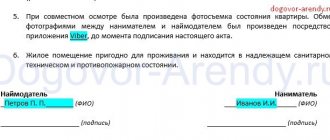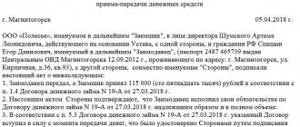return of the apartment to the rental agreement No._______ dated “___”___________20__.
Moscow city “____”_____________ 201__
We, citizen of the Russian Federation Ivanov Ivan Ivanovich, born 02/01/1980, place of birth: Moscow, gender male, passport 11 22 333456, issued by the Department of Internal Affairs of the ______ district of the city of Moscow 03/01/2000, department code 000-100, registered at the address: Moscow, street, house, building, apartment, hereinafter referred to as the Seller, on the one hand, and
citizen of the Russian Federation Petrova Ekaterina Andreevna, born 01/01/1984, Moscow, gender male, passport 22 33 555556, issued by the Department of Internal Affairs of the ______ district of Moscow on 02/01/2004, department code 000-100, registered at the address: Moscow, street , house, building, apartment, hereinafter referred to as the Buyer, on the other hand, collectively referred to as the Parties, in accordance with Article 556 of the Civil Code of the Russian Federation and with the Apartment Purchase and Sale Agreement concluded “____”_____________ 201__ in the city of Moscow between the Seller and the Buyer, have drawn up this act (hereinafter referred to as the Act) on the following
- The Seller transferred and the Buyer accepted apartment No. 1 (One), located at the address: Moscow, street, house, building, apartment, consisting of 4 (Four) rooms, with a total area of 75.4 sq.m., sq.m. ., including living area – 51.9 sq.m.
- The buyer fully paid the cost of the apartment in accordance with the above agreement.
- The apartment specified in clause 1 of the Act is transferred in good condition and suitable for habitation.
- The buyer has no complaints regarding the condition of the transferred apartment.
- The apartment is transferred without debts for maintenance and utilities. If a debt is discovered for utilities and maintenance, the Seller undertakes to pay off the accrued debt at its own expense up to the date of signing this Transfer Deed.
This Act is drawn up and signed in 2 (Two) copies having equal legal force.
____________________________________________________________________________________________
Ivanov Ivan Ivanovich
Petrova Ekaterina Andreevna
_______________ "____"________________20__
1. In connection with the expiration of the lease agreement for the apartment located at the address: ________________________________________________________________, hereinafter referred to as the Apartment, the Tenant transferred and the Landlord accepted the Apartment, the keys to the Apartment, as well as the Property in accordance with the Certificate of Transfer of the Apartment and Property from “____ »______________20__
We invite you to familiarize yourself with the terms of free privatization of apartments and housing in Russia: until what year has it been extended and what will happen next?
_________________________________________________________________________________________
_________________________________________________________________
4. At the time of signing this act, the Tenant guarantees the absence of claims from third parties in connection with the temporary paid possession and use of the Apartment and Property by the Tenant, as well as the absence of debts for the use of subscriber telephone No. _______ - ____ - __________ and for other payments provided for in the rental agreement.
5. Due to the identified deterioration in the condition of the Apartment, malfunction and (or) incompleteness of the Property, the Tenant compensated the Landlord for property damage (damage) caused to the Apartment and Property in the amount of _____________ (__________________________________________________________).
6. The Lessor returned to the Tenant the amount specified in clause 3.5. rental agreement, minus the above payments, as well as for ___________________________________________________________________________
______________________________________________________________________________, which amounts to the amount of _____________ (________________________________________________)
Lessor: _____________________________________ ___________________________________
surname, first name, patronymic in full signature
Employer: ________________________________________________________________
Certificate of return of residential premises
The formation of an act of return of premises under a lease agreement usually occurs in cases where the lease agreement is terminated for some reason. The act is not an independent document, but serves as an annex to the main agreement, becoming an integral part of it.
Advertisements without intermediaries
https://www.youtube.com/watch?v=ytpressru
The act of delivery (return) of residential premises is required by the Landlord (the person transferring the residential premises for rent) and the Tenant (the person receiving the residential premises for rent) at the time of the actual return of the residential premises from such rental (rent).
This document has been developed for legal registration of termination of the Tenancy Agreement for residential premises and eviction of the Tenant.
In the proposed template for the Certificate of Delivery (Return) of Residential Premises, the Landlord and Tenant have the opportunity to record the most important points: (i) the condition of the transferred residential premises; (ii) a list of household appliances, furniture and other utensils returned along with the residential premises; (iii) indicators of electricity, gas, hot and cold water meters; (iv) possible deficiencies in the residential premises and/or equipment located in it that arose during such a rental period.
In addition, this Act provides for the opportunity for the Landlord and Tenant to record the fact of the return of the previously transferred deposit amount, as well as the keys to the residential premises.
Please note that this Act cannot be used:
- upon actual transfer of the object directly for rent from the Lessor to the Lessee. In this case, you must use the Property Lease Transfer Certificate.
- upon actual return of the object from the lease back to the Lessor and termination of the concluded lease agreement. In this case, you must use the Certificate of Return of Property from Lease.
- upon actual transfer of residential premises for rent to an individual for subsequent residence in it. In this case, it is necessary to use the Certificate of Transfer of Residential Premises for Lease.
How to use the document
This Certificate of Delivery (Return) of Residential Premises can be used by the Landlord and the Tenant to legally formalize the fact of the return of residential premises from rental (lease). The developed template for the Certificate of Delivery (Return) of Residential Premises is suitable for any rental agreement for an apartment, room or other real estate previously concluded between the Landlord and the Tenant.
In order for the Certificate of Delivery (Return) of Residential Premises to have legal force, it must be signed by both Parties and also sealed if the Landlord and/or Tenant are legal entities.
The proposed draft Act can be used by lawyers, employees of legal departments of state and private enterprises and companies, individuals or individual entrepreneurs independently for the purpose of legally recording the fact of the return of residential premises from rent.
The act of delivery (return) of residential premises was drawn up in accordance with the requirements of practice, as well as with the application of the norms of the Civil Code of the Russian Federation.
To correctly fill out this form, you will need the original documents on the basis of which the apartment was rented, as well as the passports of the landlord and the tenant.
- In the header you must make a link to the current rental agreement for residential premises, indicating the date of its conclusion. Below we write the city and date on which this act is drawn up, as well as the full names of the landlord and tenant. As can be seen from the photograph presented above, the first point documents the fact of the return of the keys and property located in the apartment to its rightful owner. All you need to do here is to indicate the address at which the rental was made and refer to the acceptance certificate that was drawn up upon check-in.
- The second paragraph states that the lessor accepts the property (movable and immovable) without any defects or damage, in the condition in which it was transferred to the lessee.
- The tenant, in turn, guarantees his landlord the absence of unpaid bills and utility debts, as well as the fact that the apartment is sublet to other tenants.
- If the landlord took a deposit from the tenant, in the last paragraph he must record its return. If there are unpaid tickets or property damage, the renter will deduct money from the security deposit to fix the problem or pay off existing debts.
We suggest you read: Is it possible to return a used car to dealers and what is the return period?
The sample return certificate indicates the amount with a comment, and below is the amount that the owner returns to the apartment tenant. Please fill in the details of the parties below. For this you will need their passport details. After the final payment and making sure that there are no claims on the returned housing, you must sign.
{amp}gt;Act of returning the apartment to the rental agreement
Design rules
The basis for drawing up an act for renting an apartment is a rental agreement, which is concluded between the owner of the property and an individual. When transferring housing for temporary use to unauthorized persons, the owner must describe all the features of the apartment in these documents (it is recommended to take photos):
- quality of repair (it is important to record the condition of the walls, floors and ceilings, what materials were used for cladding, what quality of plumbing, gas stove, etc. were installed);
- availability of household appliances, furniture;
- security systems;
- availability of new windows and doors, etc.
Attention! After the parties sign a lease deed (a sample is located a little lower) of the property, all responsibility for the safety of material assets falls on the tenant.
Procedure for signing the act
https://www.youtube.com/watch?v=ytadvertiseru
The process of drawing up a rental agreement is regulated by the Civil Code of the Russian Federation, in particular Article 671.
Drawing up an act of return of the apartment is not a prerequisite for signing a rental agreement. The legislation does not have a specific standard form for this act. This act is drawn up together with the act of transferring the apartment for temporary use.
The acts are drawn up with the consent of the parties when signing the main agreement and are printed in duplicate. If drawn up correctly, it subsequently provides a guarantee that the residential premises will be returned in the same condition in which they were handed over for use. The act is also used for early termination of a tenancy agreement.
Only after the parties sign this act is it considered that the owner of the residential premises has no claims against the tenant.
The landlord may require the tenant to leave the property (Article 619 of the Civil Code of the Russian Federation) if:
- the rules of use were violated (for example, the contract established a smoking ban, and the tenant systematically violated it);
- he significantly worsened the condition of the premises and did not carry out major repairs within the period established by the contract, if so provided for in the contract;
- Rent was not paid on time more than 2 times in a row.
The tenant also has the right to initiate early termination of the transaction (Article 620 of the Civil Code of the Russian Federation):
- the landlord creates obstacles to the use of the premises (does not give up the keys, continues to use the premises if the latter is not established by the contract, etc.);
- the premises have shortcomings (terrible condition, repairs required, etc.) that were not discussed and were not discovered by the tenant during a personal inspection before the transaction was concluded;
- the lessor (if provided for in the contract) does not carry out major repairs on time;
- use of the premises is impossible due to its condition.
Information for the document
The purchase and sale of an apartment is a fairly common civil law transaction. Based on this agreement, the buyer purchases an apartment and pays a certain amount of money for it, and the seller transfers his ownership rights to him for the amount specified in the agreement.
Some articles of the Civil Code of the Russian Federation are devoted to this civil transaction. In particular, these legal relations are regulated by the general provisions on purchase and sale (Articles 454 - 491), as well as Art. 549 – 558, which are devoted to the purchase and sale of real estate.
The law also regulates the procedure for transferring real estate to the buyer. In particular, paragraph 1 of Art. 556 of the Civil Code of the Russian Federation states that the transfer of real estate is carried out on the basis of a transfer deed or other similar document signed by the parties to the agreement.
We suggest you read: How to transfer a share in an apartment to a relative
The presence of a signed apartment purchase and sale agreement does not yet indicate that the apartment has been transferred to the seller.
Important! Current legislation states that ownership of real estate arises after state registration. Accordingly, the buyer becomes the full owner of the apartment only after state registration and receipt of a certificate of ownership of the apartment.
But even the presence of state registration does not indicate that the apartment was transferred to the buyer. Indeed, in practice, there are often cases when the buyer and seller sign a corresponding agreement, the seller receives the agreed amount, and the buyer’s ownership rights receive state registration, but by joint agreement the seller continues to live in the apartment for a certain time. Of course, such a provision must be included in the text of the sale and purchase.
But the fact of transfer of the apartment to the buyer is confirmed by signing the corresponding act of acceptance and transfer of the apartment.
The legislation does not establish any form of this document. It can be compiled in any form. But the text of the transfer and acceptance certificate must contain certain information. In particular, the following information must be written in the text of the act:
- details of the parties (full name, address, passport details);
- data of the representative, if instead of a party to the contract, the act is signed by his representative (in this case, it is also necessary to indicate the number and time of execution of the power of attorney);
- place and time of drawing up the act;
- data of the apartment that is being transferred (address, area);
- the condition of the apartment at the time of transfer and signing of the deed.
Important! In practice, there are cases when the apartment was leased, and the lease agreement had not expired at the time of its sale. Current legislation states that the tenant retains his rights even if the owner changes. Accordingly, if the apartment is an rental property and the contract has not expired, an appropriate entry must be made about this in the text of the transfer and acceptance certificate.
The text of the act must also indicate that the buyer does not have any claims regarding the transferred apartment. If any, you must indicate them.
The next issue that needs to be paid special attention to is the presence of rent debt. In particular, the deed must indicate that the previous owner has no accumulated rent debts. And if there are any, then the obligation to pay them is borne by the previous owner.
We invite you to familiarize yourself with How to issue a deed of gift for an apartment in 2020
Signing such a document has a certain meaning. In particular, paragraph 1 of Art. 556 of the Civil Code of the Russian Federation states that the seller’s obligation to transfer real estate is fulfilled after signing the corresponding transfer document, unless, of course, otherwise is provided in the purchase and sale agreement concluded between the parties.
The legislation also states that the evasion of one of the parties from signing a document on the transfer of real estate is considered a refusal to fulfill the obligation to transfer or accept property.
Who draws up the act
The direct task of drawing up the act is usually assigned to an employee of the enterprise that is the lessor. This may be the organization’s legal adviser, or an employee/manager of the structural unit in charge of lease agreements and their execution. The main thing is that this person has an idea of how to draw up this kind of paper and is familiar with the legislation of the Russian Federation. The act must be signed either by the head of the lessor company or by a person acting on his behalf.
If the dispute between the parties who did not draw up the act reaches the court, the following may happen:
- The claim will not be accepted due to the lack of necessary documentation.
- If the claim was nevertheless accepted, the absence of a return certificate will be discovered during the consideration of the case, and the court will not satisfy the plaintiff’s demands.
- In court, the absence of an act will serve as the basis for canceling the termination of the lease agreement.
The absence of signatures entails the recognition of any document as invalid, i.e., the termination of the lease agreement will also be canceled in court.
Filling Features
When renting out a property for temporary use, an acceptance certificate is drawn up (a sample is located a little higher) in free form, which should reflect the following information:
- Place of compilation. In this case, the form can be drawn up both in the property being leased, and in a notary or lawyer's office.
- Number and date of the contract.
- Personal data of the tenant and owner of the property (indicate the series and number of the passport, residential address, full name, contact numbers).
- The main characteristics of the apartment (usually all the nuances are specified in the contracts).
- A list of all property located in the facility that is transferred for temporary use to the tenant.
- The number of keys transferred to the tenant is indicated (if the owner still has the keys, this is necessarily reflected in the document).
- It is recorded that the parties have no claims against each other.
Important! If the parties have agreed on all the points regarding the upcoming transaction, they sign each copy of the act.
Tags: apartment, transfer, reception, delivery
« Previous entry






